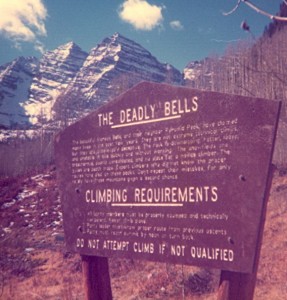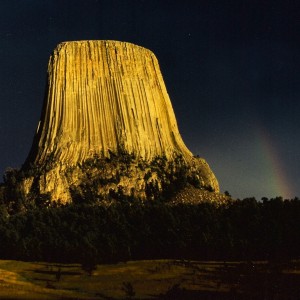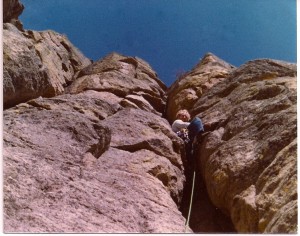I moved to Aspen because of the skiing, but I quickly discovered the many other pastimes that the Rockies afforded. The Elk Range was my backyard, and most of my summer weekends were spent exploring the local peaks.
It didn’t take long to find out that descending is often the most dangerous part of climbing, and that it is very easy to get lost on the big mountains. A casual day hike near Maroon Lake turned into a near epic, when I decided to descend a steep couloir on the East Face of one of the small peaks. The rock was very loose and the route was a lot steeper than I had guessed, but somehow I managed to get to the bottom without slipping. I learned a valuable lesson and vowed to be a lot more careful in choosing my descent routes.
The Maroon Bells are one of Aspen’s famous landmarks and a sign near the trail read, “Warning The Deadly Bells,” but the friendly man at the local climbing shop said that they really weren’t that difficult, as long as you stayed on the route. Most of the many accidents had involved climbers who had lost the route on the way down and had encountered steep cliff bands of very loose rock. He drew a sketch of North Maroon Peak on a notepad and wished us luck.
I convinced one of my ski buddies that it would be a great training exercise, so we started with the first rays of light and ran along the forested trail to the mountain. The terrain changed as we scrambled above the trees into the high alpine zone, where a few patches of snow still lingered, and the tiny plants were taking full advantage of the short summer season. A small family of mountain goats was taking a morning siesta in the warm sun and stood up to greet us as we passed. The high mountain air was brisk, but the sun was warm and the scenery was fabulous, so we raced up the ridge and enjoyed a casual lunch on the summit. When you climb to the top of a mountain you see more mountains to climb, and the rest of the Elk Range beckoned us.
“Wow! Pyramid sure looks cool from here. Wanna go next weekend?” I exclaimed.
“Maybe,” replied Danny with a chuckle. “We have to finish this one first.”
We carefully retraced our steps and arrived back at the trail without any problems.
The “Deadly Bells” hadn’t felt so deadly, and we had gained a new sense of confidence. We now knew that if we were careful and followed the established routes, it was quite safe to travel in this majestic environment.
That summer we climbed all of the fourteeners in the Elk Range and started to do some of the local technical routes. I saved enough money to purchase a rope and a few pieces of gear and learned a few basic skills from some of the local climbers and two books by Royal Robbins “Basic Rock Craft, and Advanced Rock Craft.”
My freestyle skiing buddies enjoyed rappelling, and we found a good spot on Independence Pass to practice. Somehow, we managed a way to link mogul training and rappelling. We found a rappel route, which was just a bit longer than the doubled rope, with a small dirt ledge below it. Another six feet further down the slope was a large grassy ledge that provided a safe landing.
The object of the drill was to rappel very rapidly. We literally flew off the end of the rope and landed on the tiny ledge. It was virtually impossible to stay balanced on this ledge, but a quick ski-like jump would slow us down and ready us to land safely on the large ledge. I wouldn’t recommend this exciting drill, but it allowed us to master our rappelling techniques and practice for the moguls at the same time.
We also managed to climb a few of the established routes. The rope helped me gain confidence, and placing the protection was challenging and fun. My skill at placing protection was probably quite bad in the beginning and my belayers weren’t very experienced, but, luckily, I didn’t have a chance to test them. The best rule of safety for lead climbing is, “Don’t fall.” It’s kind of like walking a tightrope with a net. The net is there, but it is better not to use it.
I was having a great time on the local peaks but my feet were itchy for travel, so I loaded all of my belongings into a 66 Impala wagon that I had purchased for 100 dollars and headed north. It was a sad goodbye to my girlfriend Trish, but the road was calling, and if our relationship was worth pursuing, we would probably get together again.
The Devils Tower is a giant volcanic plug that dominates the scenery of the Black Hills of South Dakota and Wyoming. It rises majestically above the rolling hills of the surrounding valley and challenges anyone to stand on its summit.
I had seen it when I was in high school, and I really wanted to climb it.
The easiest route was a 5.7 and soloing was strictly forbidden, so I parked my car and explored the small park. There were very few climbers in 1974, but a friendly ranger named Dan offered to be my partner on his next day off. That was almost a week away, so I set up my camp and took a bike ride to explore the local neighborhood.
The Belfouche River meandered slowly along the eastern slope of the great tower, and the green meadows of the Black Hills were filled with large herds of antelope and deer. As I peddled onward, I noticed a small town and a large group of men building something, so I stopped to investigate.
“Hi! What are you building?” I asked. “Our main saw building burned to the ground about a month ago, and we need to rebuild it before we can restart the mill,” the foreman replied.
“Do you need any help? I’m a pretty good carpenter and I could use some work.”
“We could sure use some help on the roof. Are you scared of heights?”
“I’m not scared of heights. I came to climb the tower, but I’m waiting for my partner to get a day off, so I could work for about a week. How much are you paying?”
“So, you’re one of those crazy climbers, eh! I’ll give you five bucks an hour, and you can start tomorrow at eight.”
Sounds great! See you tomorrow.”
I was very excited about my sudden stroke of good luck, because my funds were low and dwindling rapidly. I bought a large steak at the market in Hulett, Wyoming, and pedaled back to enjoy a great feast in the campground.
The loggers were fun to work with and they let me camp at the job site. It wasn’t quite as pleasant as the tower campground, but it was free, and the commute was very easy. The local workers thought that rock climbers were quite crazy, but they didn’t seem to hold it against me. At the end of the week, we shared a few beers and they wished me luck, as I said goodbye and headed back to the tower.
Dan was happy to see me and offered me dinner and a place to sleep for the night.
We were up before dawn and scrambled up the exposed trail to the base of the Durrance route.
“OK! This is it.” Dan said, as we looked up at the route. “The second pitch is probably the crux, but the pitches are all quite similar.”
“That first pitch looks like fun. I’ll take it,” I replied, as I rapidly prepared my rack. It was very good to be climbing again and most of the first pitch was a sheltered chimney, which felt quite secure. Most of the protection was fixed, and I scurried up to a very friendly ledge on top of the column. Dan quickly followed and cruised up the next pitch to another ledge. The second pitch felt more difficult, but I managed to struggle up to the next ledge.
“Nice lead. That felt a little harder than the 5.7’s in Aspen, but I enjoyed it. I guess it’s my turn again, eh?”
The next pitch was called the “cussing crack” and involved a strenuous chimney. I struggled up to the first fixed pin and was very happy to clip into it. After a brief rest, I continued upward, but my crack technique was a bit sloppy and my legs started to shake as I struggled to hang on to the slippery rock.
“Yow! Glad I didn’t try to solo!” I exclaimed, as I fell back below the fixed pin. It was my first lead fall, and I was very happy to have a rope and a good belayer.
“You really need to twist your feet into that crack,” Dan advised. “You’re trying to do everything with your arms.”
“Thanks. I’ll try it.”
Dan was an experienced climber, and he gave me some very valuable coaching as we swung leads on the varied route.
“Wow! That feels a lot better,” I said, as I cruised up to the next ledge.
We had the whole tower to ourselves and enjoyed a perfect day on a classic route which involved chimneys, jamming, and a little stemming. When we arrived at the summit, he congratulated me and showed me some cow pies that he had left there on a previous trip. He was easily amused and enjoyed the comments of the climbers that found them.
We celebrated with a barbecue at his cabin, and his wife gave me the address of her brother, who was living in Jackson Hole, Wyoming. The Grand Teton was next on my list, so the information was very helpful.
I reached Jackson Hole about noon and parked the old wagon next to the Town Park. Lunch in a fancy restaurant did not fit in my budget, so I made a peanut butter sandwich and enjoyed it next to the arch of antlers.
The next stop was Teton Mountaineering, where I asked about routes up the Grand Teton and bought a copy of the local guidebook.
“Hi! How ya doing? What is the easiest route on the Grand Teton like now?”
“There really aren’t any easy routes, and I think that you need to hire a guide,” replied the somewhat arrogant cashier.
“Have you climbed it?”
“No!” he replied.
“How much is this guidebook?”
“Five dollars.”
“Sold!” I replied, and returned to the park to read it carefully. The Owen-Spaulding seemed like the only reasonable route for a solo at my ability, but I would need two ropes for the rappel, so I wandered back into the store.
“How much is that seven-mil rope?” I asked.
“It’s ten cents a foot, but I really recommend the 8 mil. It is a lot stronger and only 14 cents a foot.”
He was probably right, but weight and cost were major factors, and the seven-mil seemed strong enough.
“I’ll take 125 feet of the seven please,” I replied, as I dug into my wallet for the cash.
My next stop was the grocery store, where I bought a hearty lunch for the next day’s climb and a big steak for dinner. The weather was perfect, so I slept out under the stars and dreamed about lofty summits.
Just before dawn, a small critter climbed across my sleeping bag and woke me. The sky was clear, and I quickly packed my small rucksack. I was not planning to spend the night, so I took only minimal gear and started to run up the trail in the crisp air of the early morning.
Suddenly, a giant animal appeared about fifty feet away, and my jog came to an abrupt halt.
“I sure hope she doesn’t charge,” I thought to myself, as I stared at a very large moose with a young calf. I was urgently looking for an escape route when the calf, which was about 90 percent legs, stumbled away from the trail. His mother followed quickly behind, and I breathed a huge sigh of relief and continued jogging.
The trail wandered through a pristine forest and soon reached the magical high alpine zone that I was learning to love. The rock was a lot more stable then The Deadly Bells, and I quickly scrambled up to The Belly Crawl Ledge. This was mentioned as one of the cruxes in the guidebook, so I studied the route carefully before starting the traverse. Crossing the ledge was easy, but it was a bit icy and very exposed, and the weather was deteriorating rapidly, so I moved cautiously. A sudden squall of icy rain slammed the mountain as I looked over the edge at the infamous North Face. But the squall passed as quickly as it had arrived, and I continued on the safe ledge to the double chimneys. This crux had a rating of 5.4, which means that a rope and technical gear were recommended, but a confident climber would find it easy. I stopped for a brief rest and studied the route very carefully. If I slipped here as I had on the Devil’s Tower, I would probably die or be severely injured, so mistakes were not an option. The route looked fairly reasonable and the weather was clearing, so I took three deep breaths and headed upwards.
The first moves were a bit scary, but they felt good and I started to relax and truly enjoy the high-altitude experience. There was a secure place to rest about half way up the chimney, so I stopped to take a breath and survey the fabulous mountain scenery.
“Wow!” was about all I could think, as I looked down at the Middle Teton and off toward the plains of Idaho. If there is a stairway to heaven, it is in the mountains, and I felt like I had found it.
After a brief rest I looked upward. The path looked easy, so I carefully followed it and arrived at the summit just in time for another squall, which dropped a bit of sleet and headed on its way. After a quick lunch, I found the rappel anchors and started to head down.
The rappel dropped me to a point off the route I had ascended, and in my euphoric state, I was a little bit careless. The scrambling became quite steep, so I turned around to face the cliff. Suddenly, one of my footholds failed, but my handholds didn’t, and I struggled to regain my balance. My heart rate soared, and my knees started to quiver, but, somehow I managed to keep my composure long enough to spot a small ledge just below me.
“OK! Breathe! Try to relax. Gotta get to that ledge!”
Mind control is a huge part of climbing, and, luckily, I was able to focus on getting to the ledge. It was safe and comfortable, and I sat in the afternoon sun and raided my pack for the remaining food. Fifteen minutes of relaxation and a large chunk of salami helped to calm my nerves, and I carefully considered my options.
The main route was in sight, but my lack of concentration had placed me on a steep section about one hundred feet away. Climbing back to the trail would involve retracing steps that I did not wish to repeat, but there was another possibility. A short rappel would take me down to some more reasonable terrain, and it was possible to place an anchor next to the ledge. Placing the anchor would mean sacrificing about three dollars worth of gear, but I figured that my life was worth at least that much. So I wrapped a couple of nylon slings around a large boulder and headed down. The tactic worked, and the rest of the descent followed an easy trail, so I ran most of the way back to my car.
Dan’s brother in law had invited me to a small barbecue, and my timing was perfect. It was a fun gathering, and I met a few locals and a very beautiful woman who was very friendly. She had been living in Jackson Hole for about a year and was a hard-core skier. As the party wound down, we laid out our bedrolls on his floor, and the beautiful woman camped next to me.




